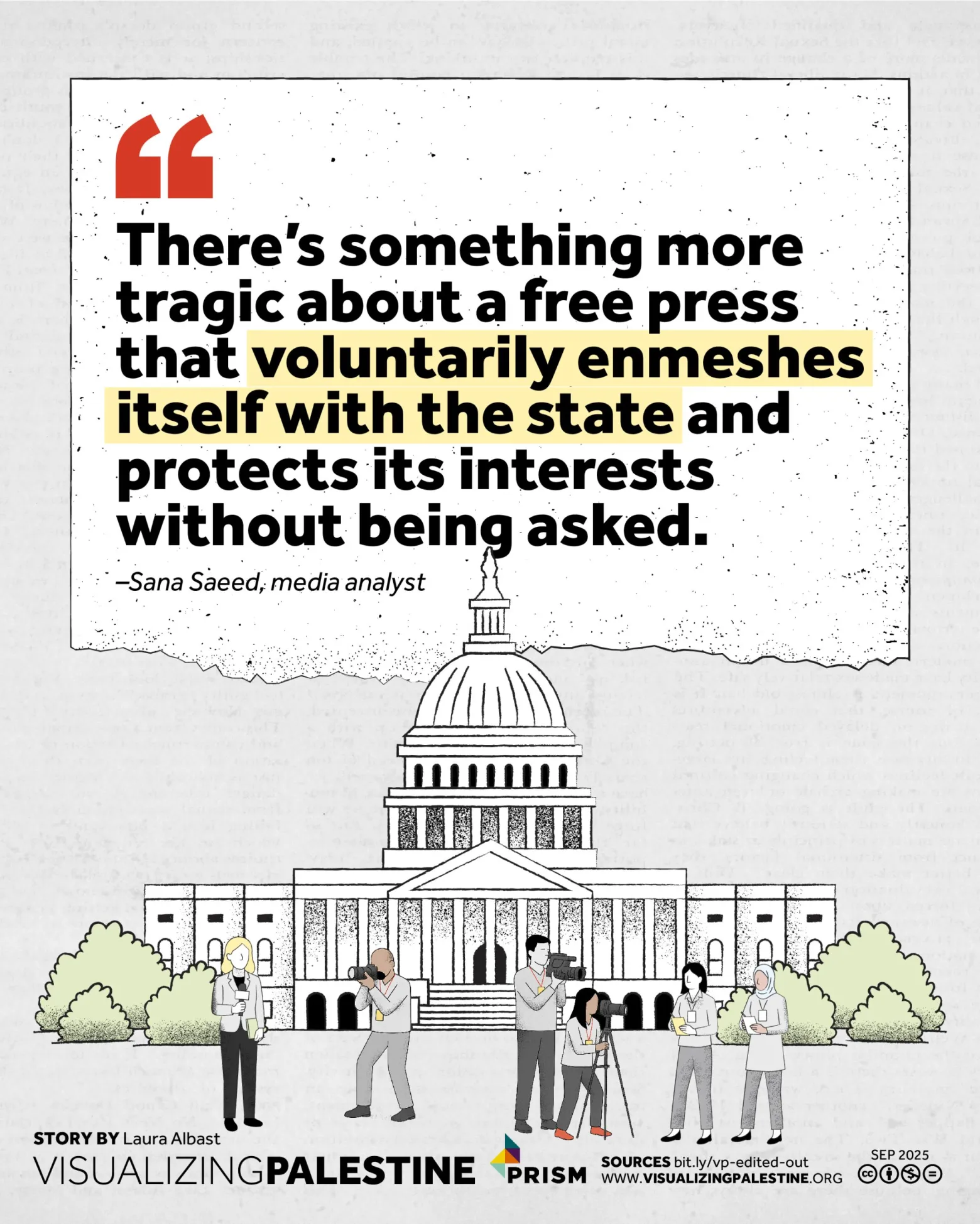Credit: Designed by Kyubin Kim
Prism partnered with Visualizing Palestine to illustrate this monthslong investigation. Through this collaboration, Visualizing Palestine’s graphics illustrate the findings of our reporting and make visible how coverage of Palestine is shaped within U.S. newsrooms—from inception to editing to publication. You can view their visuals here.
After eight years of reporting on communities of color for a local news outlet based in the Northeast, Nadia had had enough. A pattern of pushback from newsroom leaders against her coverage of Palestinians had culminated in conditions she refused to put up with any longer. In the months following the start of Israel’s genocide in Gaza, Nadia finally quit her job.
The last critique her editors leveled against her involved a story she pitched about a local Muslim art exhibit. Her editors thought it was about Palestine. It was not.
“They gave me this whole spiel about how ‘there’s before Oct. 7, and there’s after Oct. 7,’” Nadia, who is using a pseudonym to avoid retaliation and getting blacklisted within the industry, told Prism.
Even though she didn’t mention Palestine in her pitch, she said her editors told her that readers would still assume it was related. The reason they gave, according to Nadia, was because the story would be published after Oct. 7—and her name would be in the byline.
“That was my breaking point,” she said. “I’m so flattened here. I’m so dehumanized here, and so is my community. I’m so devalued and disrespected, and I can’t keep running on fumes.”
Nadia’s experience is one of nearly a dozen accounts Prism heard from journalists in newsrooms across the U.S. who described pushback from editors and managers surrounding coverage that centered, or even mentioned, Palestinians, particularly after Hamas’ Operation Al-Aqsa Flood on Oct. 7, 2023. The journalists, who are Palestinian, Arab, or Muslim, told Prism that they were shut out of covering Israel’s genocide in Gaza, while white, Jewish, or Israeli journalists took the lead. They said they witnessed Palestinian voices and stories being quashed, as external Zionist groups unleashed campaigns of complaints and harassment against such reporting. Meanwhile, the journalists said their news outlets’ coverage of the genocide remained inadequate and even dangerous, as U.S. mainstream media adopted a pro-Israel bias that muzzled the truth about Israel’s violence.
“There’s always been a strong bias toward the pro-Israel side for many different reasons,” said William Youmans, an associate professor in residence at Northwestern University in Qatar who researches global media, law, and politics. “Ranging from U.S. foreign policy to the status of pro-Israel organizations, there’s a strong domestic constituency that’s quite active for the pro-Israel perspective.”
A pattern of pushback
As Israel accelerated its genocide of Palestinians in Gaza at a devastating pace, killing more than 63,000 including more than 276 members of the press, U.S. journalists pushed back against the status quo in their newsrooms. In November 2023, hundreds signed letters demanding fair reporting and accountability from newsroom leaders, though many expected retaliation and requested anonymity. Several similar letters have been published since.
In September 2024, the National Writers Union released a report titled “Red Lines: Retaliation in the Media Industry During the War in Gaza.” The report tracked 44 cases of retaliation against more than 100 media workers in the U.S. who have been perceived to be supportive of the Palestinian cause or critical of Israel. Forms of retaliation included termination of employment, cancellation or restriction of assignments, suppression of journalists’ social media activity, online harassment, and the rescission of awards. At least three reporters were forced to resign.

Journalists like Nadia shared similar experiences with Prism. But like most reporters working to produce fair coverage of Palestine, Nadia’s story began well before Oct. 7, 2023.
A few years ago, one of Nadia’s pieces involving a local Palestinian American attracted “a massive Zionist campaign to silence me,” she recalled. Complaints flowed in to the outlet via email and phone calls for about a year.
“The newsroom didn’t take the article down, but they were very, very cautious after that,” Nadia said.
Multiple stories she pitched related to Palestinians, such as a local event commemorating the Nakba—the ethnic cleansing and mass dispossession of Palestinians by Zionist militias during the creation of Israel in 1948—were rejected or killed before being published. Nadia described these actions as a “double standard.” She was told that the local news outlet doesn’t cover international news, despite publishing dozens of pieces about Ukraine and the women’s rights movement in Iran.
“The beginning of the end” of Nadia’s tenure with the local publication came when she was assigned to write a piece about Palestinian cooking.
One of her sources spoke about the cultural appropriation of food, which, according to Nadia, “ruffled some feathers in the newsroom.” Some colleagues suggested those quotes be removed, which Nadia saw as an affront to journalism.
“In what world, in what journalism class, were we taught that if someone is quoted saying something that could offend some subset of people, then we don’t include those quotes in the story?” Nadia said. “Our job is not to worry about people’s feelings. Our job is to just represent the people who we’re interviewing, the stories that we’re telling, the events that are happening in the world wholly, factually, accurately.”
Though Nadia reluctantly added a few lines of context from a pro-Israel perspective, the newsroom still received a lot of negative criticism for the story. Nadia was forced to meet with the editor-in-chief, who told her that he considered taking the article down from the website.
“The only reason he decided not to do that is because he had personally read and signed off on the article,” Nadia said. “He told me that he decided that I can’t write these stories anymore.”
After Oct. 7, senior leadership informed her “that the bar had risen significantly in terms of what I could and couldn’t report on,” Nadia said.
She said she was also barred from freelancing for other outlets, as newsroom leadership believed that would threaten the appearance of her objectivity and thus, her position with the paper. Nadia told Prism that there was no organization-wide rule preventing reporters from freelancing for other outlets and that other reporters did so regularly.
Nadia’s productivity declined. She was watching a genocide unfold, and the one tool she had to make an impact—her writing—had been taken away.
“I was just sitting there with my hands tied,” she said.
Other reporters interviewed by Prism said that many of the conversations they had with editorial leadership about their Palestine coverage happened in person, via Zoom, or over the phone. Across the board, editors and executives avoided putting any of their directives regarding Palestine reporting—or restrictions placed on reporters—in writing.
Pro-Israel bias
The majority of journalists Prism interviewed reported that when the genocide began, newsroom leadership designated one reporter to lead coverage on the unfolding events. They said the reporter was typically white and male and often had little knowledge about the Middle East.
The perception in newsrooms, the journalists told Prism, was that having Palestinian, Arab, or Muslim heritage made a reporter biased and unable to accurately cover Palestine and Israel.
If you have a story to share about U.S. newsrooms’ repression of Palestine stories, contact Laura Albast at palmediaworker@proton.me.
Salma, who requested to use a pseudonym out of concern that speaking publicly could harm her career, is a Palestinian journalist who worked at the Washington, D.C., office of an international media outlet for seven years. She lost family members to Israeli airstrikes in Gaza. During the first week of the genocide, Salma told Prism, the executive producer asked her in front of her co-workers, “Can you be objective?” She quit shortly afterward.
Meanwhile, many of the journalists covering Israel and Palestine at the most widely read newspaper in the U.S. are either related to current or former Israeli soldiers or have themselves served in the Israeli military.
On July 16, Writers Against the War on Gaza (WAWOG), a coalition of media, cultural, and academic workers, published an interactive dossier revealing the connections between journalists at The New York Times and Israel, its military, and the pro-Israel lobby in the U.S. The goal was to refute the paper’s claims of objectivity in its reporting, WAWOG told Prism in a statement.

The dossier, described as an ongoing project, lists 21 current and former staff of the paper and their ties to Israel or the pro-Israel lobby.
“[The Times’] journalists are compromised, whether they have been trained by Israel’s military, live in a stolen home, or collaborate with institutions designed to produce favorable media and exert political pressure,” WAWOG told Prism. “The double standard has been institutionalized across its labor and editorial practices, to make the Times not just stenographers of Israel’s crimes but active participants.”
For example, the Times’ Jerusalem-based correspondent has repeatedly relied on analysis provided by an Israeli propaganda think tank where her husband worked without disclosing to readers, according to WAWOG’s dossier. Her husband, a prominent and outspoken pro-Israel pundit, served in the Israeli military, as have their two sons, the dossier says.
In another example from the dossier, the author of a widely discredited story in the Times, which advocates say weaponized false claims of rape on Oct. 7, is a former intelligence officer with the Israeli Air Force and apparently had no prior journalism experience. The New York Times has said that it stands by the story despite questions surrounding various claims, including by the paper’s own audio producers and the Israeli family whose account was featured.
“The dossier you reference is part of a vile campaign aimed at intimidating journalists and media executives because of fair-minded reporting and news coverage,” New York Times Communications Director Nicole Taylor told Prism in an email. “Rather than criticize the specifics of our journalism, this campaign chooses to make personal attacks and innuendo based on a person’s faith or ties to a group or country, all of which are public knowledge, and some of which are inaccurate, in an attempt to discredit our reporting.”
Taylor did not respond when Prism asked which parts of the dossier are inaccurate.
“We’ve had reporters from many nationalities covering the conflict, including more than a dozen Palestinian journalists who, over the past two years, have chronicled this war, many while enduring it themselves,” Taylor said, including freelance photojournalist Samar Abu Elouf, who won the 2025 World Press Photo of the Year for her image of 9-year-old Mahmoud Ajjour, who lost both of his arms as a result of an Israeli airstrike. Taylor said Abu Elouf and Gaza-based freelance photojournalist Yousef Masoud were also part of the team that won the 2024 Pulitzer Prize in International Reporting for their coverage of Oct. 7 and Gaza.
The New York Times and other mainstream U.S. outlets have published stories focusing on human suffering in Gaza. However, according to journalist and media critic Sana Saeed, news outlets often use these stories—many of which win awards—to defend themselves when accused of bias. Those pieces don’t tell the full story of the genocide, she said.
“These types of ‘good stories’ still diminish the role of the United States and Israel in the genocide itself, in terms of the war crimes [and] the atrocities that have been committed against the Palestinian people,” said Saeed, a former correspondent and senior producer with AJ+, part of Al Jazeera Media Network.
Several other news outlets also feature coverage of Palestine led by journalists with ties to the Israeli military or to pro-Israel lobby groups. Axios’ Middle East expert served in the Israeli intelligence corps, according to multiple media reports. The Atlantic’s editor-in-chief volunteered to serve in the Israeli military and wrote a book about his time as a prison guard in an Israeli detention facility.
In January 2024, The Wall Street Journal published an article alleging that staff at UNRWA, the United Nations agency for Palestinian refugees, had ties to Hamas. The story played a role in legitimizing the collapse of UNRWA’s role in distributing aid within Gaza, paving the way for the Gaza Humanitarian Foundation (GHF) to take over this year. Israeli forces have deliberately shot at Palestinians seeking aid, according to reports, and nearly 2,000 people have been killed at GHF aid sites.
Almost six months after the story published, the Journal admitted that it could not verify the allegations it reported. The story was reported by a former Israeli soldier employed by the paper, who, up until 2023, was actively engaged in pro-Israel advocacy, according to screenshots of a now-deleted article by a pro-Israel organization.
Axios, The Atlantic, and The Wall Street Journal did not respond to Prism’s requests for comment.
“What we find is that in almost every single major story … former Israeli soldiers are leading the bylines of stories that are very clearly intended to be propagandistic, and that have also been proven to be false,” Saeed said.
She said these assignments also reflect how race plays into news coverage and who is allowed to tell the story of Palestinians.
The lack of Palestinian input is showing up in the coverage. An analysis by The Intercept reviewed coverage by The New York Times, The Washington Post, and The Los Angeles Times during the first six weeks of the genocide. It revealed “consistent bias against Palestinians,” favoring a pro-Israel narrative. Reporters and editors frequently used emotive language to describe Israeli deaths, but not for Palestinians. Palestinian children were often stripped of their childhood, described instead as “minors” or individuals “under the age of 18.”
“We don’t have state-controlled media,” Saeed said, “but there’s something so much more tragic about a free press that voluntarily enmeshes itself with the state and protects its interests without being asked.”
“On the sidelines for a whole year”
Eman Mohammed, a freelance photojournalist from Gaza, experienced firsthand how Palestinian journalists are shut out of coverage. Mohammed was based in Washington, D.C., working with outlets such as Mother Jones and Business Insider before she moved to Ireland last year.
Much of Mohammed’s work involved covering Palestinian stories, including those from Gaza. When the genocide began, two of her clients immediately dropped her, she said, despite her relationships with these outlets spanning at least five years. The outlets had expressed interest in a trip to Gaza she had planned for Oct. 9, but after Oct. 7, they abandoned working with her.
“Their reaction was so severe and so aggressive, it felt like I was being retaliated against,” Mohammed said.
Mohammed moved to the U.S. from Gaza in 2015, seeking treatment for her daughter—an American citizen—who was injured by an Israeli bomb during the 2014 assault on Gaza.
She said that after the latest onslaught began, one of the outlets, which she can’t name due to a contractual agreement, commissioned her to write an essay about Gaza. She submitted 2,000 words within a few days. They were never published, and she said the only reason she was given was, “These things happen.”
“It was so humiliating that they came to me, asking me to write about the siege, about my family,” she said. “I think they needed to rely on ‘locals’ like me.”
Meanwhile, NPR, which Mohammed had worked with for years, had commissioned her to take portraits for a different story related to Gaza. Shortly afterward, she learned that the outlet had reassigned the story to a different photographer. Mohammed said her editors did not respond to her emails asking what happened.
“The way they killed my material was violent to me … emotionally triggering and unethical,” said Mohammed.
NPR did not respond to Prism’s requests for comment.
Mohammed said that typically, NPR communicated to her about any budget restrictions surrounding upcoming assignments. The public broadcaster had paid for her to attend Hostile Environment and First Aid Training, designed for journalists reporting in conflict zones or at protests, to prepare her for an assignment in Ukraine, which, after Oct. 7, did not end up happening. At that point, Mohammed said she stopped hearing from NPR with any assignments and was not given a clear explanation why.
Mohammed said she did not expect such treatment from NPR, like she did with The Wall Street Journal, another outlet she said stopped reaching out to her with assignments after Oct. 7.
One year after the genocide began, Mohammed said new editors at NPR and the Journal both contacted her with assignments, which she declined.
“I was on the sidelines for a whole year,” she said.
Terminology debates
Prism interviewed several mid-career journalists who said they felt isolated in their newsrooms after losing battles to push for more accurate coverage around the genocide of Palestinians. A lot of those battles involved debates over specific language or newsworthiness.
Farah, a reporter who left the industry after a decadelong career, covered education at a newsroom where she’d worked for a year. After Oct. 7, Farah’s editor asked her to collect local reactions and reach out to student groups. One of the groups the editor suggested was Hillel, a pro-Israel campus organization that often targets Palestinian students and lecturers. Farah, who is using a pseudonym to discuss internal newsroom conversations more freely, asked her editor, “What are we doing to include Palestinian voices?”
Farah said her editor claimed she had only used Hillel as an example of a student group. But Farah remained skeptical and uncomfortable about the newsroom’s immediate inclination toward pro-Israel voices.
Farah shared a guide on reporting about Palestine and Israel prepared by the Arab and Middle Eastern Journalists’ Association (AMEJA) with her editor, who subsequently shared it with the wider newsroom on Slack.
In a later story Farah wrote, her editors wanted to describe the displacement of Palestinians from Gaza as an “eviction.” Farah referenced the AMEJA guide, which notes that calling the occupation a “real estate dispute” obscures Israel’s forcible displacement of Palestinians. She said her editors also wanted to remove the word “apartheid” from her report, even though it was within a quote, asking Farah if it was “too simplistic to say their ‘mistreatment’ of the Palestinians” instead. Multiple human rights organizations have determined that Israel’s treatment of Palestinians amounts to apartheid. Farah’s story ran with “apartheid” in quotes.
“That was my first experience with the clashing back-and-forth,” Farah said. “I feel like they’re afraid to make a call on it, even though they make calls on things all the time.”
Harassment campaigns
Journalists who spoke to Prism said it wasn’t hard to see why newsroom leaders scrutinized each word in articles about Palestine. Stories that conveyed Palestinian perspectives faced intense pressure campaigns from outside groups, who sent flurries of email complaints to newsrooms.
Ziad, an editor at an U.S.-based news network, said he was frustrated with the power that these pro-Israel groups had over news coverage.
“I live with it every day,” Ziad said, “and I am tired.”
Ziad, who is using a pseudonym because he still works at the news outlet, said most of the complaints his supervisors share with him are from the Committee for Accuracy in Middle East Reporting and Analysis (CAMERA), a pro-Israel group that publicly encourages U.S. newsrooms to adopt Israeli talking points.
“We don’t have a Palestinian or Arab or international institute that does similar work to that of CAMERA and Canary Mission,” Ziad said. “The majority of the pressure is coming from one side.”

Youmans, the media researcher, said the pro-Israel lobby is much better at producing “flak,” or negative feedback directed at newsrooms.
“What it does is it raises the inconvenience cost to editors and producers whenever they touch any of these stories,” Youmans said.
Pro-Israel lobby groups target senior management and question staffers’ editorial decisions, Zaid said, demanding to know, “Why was this word said? Why did you invite this guest?”
One such incident occurred after a Palestinian source spoke to the outlet about Israel’s occupation.
“We received so many complaints, and we got a legal threat from a pro-Israel media group,” Ziad recalled. The network also lost a sponsor who complained that the outlet lacked strictly pro-Israel coverage, he said.
Ziad said he has noticed a generational divide in his newsroom, with pro-Israel voices mostly over the age of 40, while the majority of younger, more diverse producers were more vocal about fair coverage of Palestine and often criticized leadership choices.
“Editorial meetings are drama; they’re combative,” Ziad said.
The Palestine exception
Even within newsrooms that are known to be more progressive in their coverage, some journalists there shared stories of pushback when it came to Palestine.
In 2023, Spencer worked with More Perfect Union (MPU), a nonprofit media organization whose website states that its “advocacy journalism mission is built on a simple credo: ‘Building power for the working class.’”
According to Spencer, that advocacy excluded labor organizing around Palestine.
Alongside other staff members, Spencer pushed newsroom leadership for answers as to why the outlet wasn’t covering stories about the genocide. They were told that the newsroom lacked the necessary expertise for such coverage, and that their focus was U.S.-based, not international. (Spencer no longer works with MPU and is using a pseudonym to avoid retaliation within the industry. Prism is not publishing Spencer’s gender to avoid revealing their identity within a smaller news outlet.)
In the meantime, the outlet’s social media pages began receiving direct messages asking if MPU would cover Gaza. When a national march on Washington was announced for Nov. 4, 2023, one employee pitched coverage.
“A big part of MPU is covering how workers can have an impact, so I thought it suited us to show that when working people stand together, they can disrupt the war machine,” Spencer said.
According to Spencer, Faiz Shakir, MPU’s co-founder and executive director and a senior adviser to Sen. Bernie Sanders, shut the idea down. On Nov. 8, Spencer said, at least 10 employees who had expressed similar concerns joined them in a 90-minute Zoom call with Shakir.
Spencer said Shakir repeated that Palestine was off MPU’s beat, which did not extend to international affairs.
“But that rang hollow to me because we were happy to cover any kind of worker organizing,” they said. “One time, we interviewed workers in Sweden.”
That same day, the American Postal Workers Union released a statement calling for an immediate ceasefire. According to a screenshot Spencer shared with Prism, an employee highlighted the news in an internal Slack channel dedicated to social media ideas.
An MPU manager responded, “I think Faiz was pretty clear that he’s not currently interested in us covering labor activism for a ceasefire.”
Meanwhile, the outlet was preparing a video that Spencer said presented a positive image of outgoing President Joe Biden, whose final year in office was marked by his nickname “Genocide Joe.” Spencer said some staffers told their managers that they were not comfortable working on the rollout of a pro-Biden video.
Later, during a staff meeting, Shakir told employees that turning down assignments was not an option.
“If we turned down work, they would take it to mean we were not interested in working there,” Spencer said.
In an email viewed by Prism, which was sent to staff following the meeting, COO Malea Stenzel Gilligan wrote, “Staff cannot refuse to work on stories they simply disagree with or don’t like,” but, she added, producers could remove their bylines or decline to host or voice over stories they did not want to be publicly connected to, per management’s collective bargaining agreement with unionized staff.
Shakir and Stenzel Gilligan did not respond to Prism’s requests for comment.
On Dec. 1, the United Auto Workers (UAW) released a statement calling for a ceasefire in Gaza.
“We got approval to cover it. But in the end, it turned out management approved language that did not mention a ceasefire or Gaza at all,” Spencer said.
The video, first published on Nov. 22, 2023, was reshared by MPU on X and Instagram on Dec. 1 after the UAW statement. The video focused on the U.S. defense industry’s inefficiencies and impact on the American economy, and appeared to be repackaged after the UAW statement was released. Israel is mentioned in two soundbites as a beneficiary of American-made weapons. However, Gaza only appears in the title of the video uploaded to YouTube, and the union’s call for a ceasefire was not included.
Spencer said most of the advocacy for Palestine coverage came from MPU’s temporary interns rather than permanent staffers. The interns wrote a letter to MPU’s unionized staff, urging them to advocate for coverage of workers who disrupt the war machine.
“We cannot engage in selective advocacy, choosing to ignore things when it is convenient,” read the letter, which was viewed by Prism. “Right now workers are protesting the use of American tax dollars to fund an ethnic cleansing. Our coverage could amplify these efforts to disrupt war profiteering and remind workers of their own collective power to enact change at work and outside of it.”
In response, the unionized reporters promised to publish social media posts addressing the interns’ concerns on the union’s accounts, which they appeared to do in some form at least twice.
This January, Shakir launched a bid for chair of the Democratic National Convention. He lost.
Soul searching
Since Israel’s genocide in Gaza began, many communities have turned away from traditional media, looking for alternative outlets, especially since traditional mainstream news continue to manufacture consent for genocide, according to Saeed, the media critic. And journalists who work for these outlets have learned that there’s little room for pushback in their newsrooms.
Saeed said that journalists may convince themselves to stay in these newsrooms because every now and then, they publish a story about the suffering of Palestinians in Gaza.
“As a journalist, you are conditioned to look at these newsrooms as a kind of landing point for your career,” Saeed said. “But the moral question we need to be asking ourselves as journalists is do we want the landing point of our careers to be in newsrooms that ultimately supported the extermination of 2.2 million people?”
![]()
By Laura Albast
Laura Albast is a Palestinian-American journalist, translator, photographer, and media analyst. Her publications and appearances include The Washington Post, The Nation, Al Jazeera, The New Arab, Prism, KPFA, and other outlets. She was formerly the editor of Palestine Square, the blog of the Institute for Palestine Studies.














